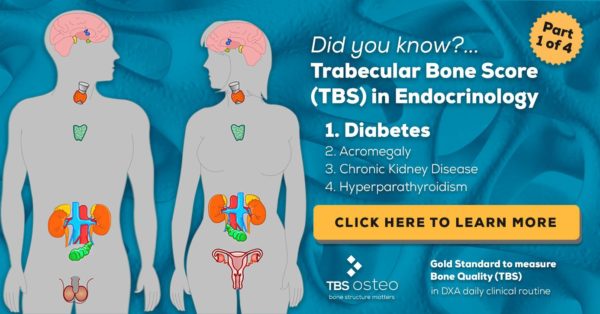To know more about TBS Osteo in Endocrinology – read document below:
Trabecular Bone Score (TBS) shows great value in improving fracture risk prediction of primary and secondary osteoporosis within daily clinical routine in conjunction with DXA BMD. That is particularly true with diseases in Endocrinology such as Diabetes, Acromegaly, Chronic Kidney Disease (CKD), and Hyperparathyroidism.
Trabecular Bone Score (TBS) in Diabetes:
Diabetic patients with poor glycemic control present an elevated risk of fracture but paradoxically their BMD is higher than in healthy patients 13,14. Poor glycemic control has been associated with high fracture risk and lower TBS values 15,16. TBS has been shown to be an excellent predictor of fracture risk in diabetic patients, independent of BMD17.
The added value of TBS in patients with Diabetes is to better estimate the fracture risk, hence improving osteoporosis management. As such, TBS has been included in the guidelines for the management of Diabetes by the International Osteoporosis Fundation 18.
If you receive a TBS report and you observe that the TBS value is in the red zone in the reference graph section, your patient has a degraded micro architecture suggesting a high risk of fracture, even if he/she was not identified at risk based on the BMD T-score alone.
Feel free to share with your Endocrinologist colleagues, as it might be helpful in identifying more patients at risk for fracture.
Reach out to us in the LinkedIn comments or write to us at support@medimapsgroup.com – we will gladly help you.
Follow us on LinkedIn by clicking here.
To know more about TBS Osteo in Endocrinology – read document below:
Why Trabecular Bone Score (TBS) adds value in Secondary osteoporosis?
Secondary Osteoporosis is caused by certain medical conditions or treatments that cause alterations of bone strength, involving bone mass and mostly bone microarchitecture deterioration, resulting in bone fragility and fracture. Since BMD only measures bone mass, providing no information on bone microarchitecture, it can underestimate fracture risk and, therefore, it may not be sufficient by itself to determine fracture risk status in these patients.
Trabecular bone score (TBS) is a texture parameter related to bone microarchitecture that provides skeletal information that is not captured from the BMD measurement2. TBS predicts osteoporotic fractures independently of BMD3,4. Added to the FRAX, the TBS’s greatest utility lies in individuals whose BMD levels are close to an intervention threshold (up to 25% of the patients will then be impacted)5. TBS has been included in many local, national, and international medical societies and guidelines 6–11.
You can find more about usage of Trabecular Bone score and fracture risk prediction in Endocrinology below:
• Trabecular Bone Score in Diabetes
• Trabecular Bone Score in Acromegaly
• Trabecular Bone Score in Chronic Kidney Disease (CKD)
• Trabecular Bone Score in Hyperparathyroidism
References for TBS in Diabetes:
13. Ulivieri, F. M. et al. Utility of the trabecular bone score (TBS) in secondary osteoporosis. Endocrine 47, 435–448 (2014).
TBS value propositions
2019 © Medimaps group. All rights reserved – December 2019, MM-PS-136-MIG-EN-04 6 | 7
14. Oei, L. et al. High bone mineral density and fracture risk in type 2 diabetes as skeletal complications of inadequate glucose control: the Rotterdam Study. Diabetes Care 36, 1619–1628 (2013).
15. Kim, J. H. et al. Trabecular bone score as an indicator for skeletal deterioration in diabetes. J. Clin. Endocrinol. Metab. 100, 475–482 (2015).
16. Leslie, W. D., Aubry-Rozier, B., Lamy, O., Hans, D. & Manitoba Bone Density Program. TBS (trabecular bone score) and diabetes-related fracture risk. J. Clin. Endocrinol. Metab. 98, 602–609 (2013).
17. Chen, F.-P., Kuo, S.-F., Lin, Y.-C., Fan, C.-M. & Chen, J.-F. Status of bone strength and factors associated with vertebral fracture in postmenopausal women with type 2 diabetes. Menopause Publish Ahead of Print, (2018).
18. Ferrari, S. L. et al. Diagnosis and management of bone fragility in diabetes: an emerging challenge. Osteoporos Int 1–12 (2018) doi:10.1007/s00198-018-4650-2.
References for Trabecular Bone Score (TBS Osteo) in Secondary Osteoporosis:
1. Siris, E. S. et al. Bone mineral density thresholds for pharmacological intervention to prevent fractures. Arch. Intern. Med. 164, 1108–1112 (2004).
2. Muschitz, C. et al. TBS reflects trabecular microarchitecture in premenopausal women and men with idiopathic osteoporosis and low-traumatic fractures. Bone 79, 259–266 (2015).
3. Hans, D., Goertzen, A. L., Krieg, M.-A. & Leslie, W. D. Bone microarchitecture assessed by TBS predicts osteoporotic fractures independent of bone density: the Manitoba study. J. Bone Miner. Res. 26, 2762–2769 (2011).
4. Iki, M. et al. Trabecular bone score (TBS) predicts vertebral fractures in Japanese women over 10 years independently of bone density and prevalent vertebral deformity: the Japanese Population-Based Osteoporosis (JPOS) cohort study. J Bone Miner Res 29, 399–407 (2014).
5. McCloskey, E. V. et al. A Meta-Analysis of Trabecular Bone Score in Fracture Risk Prediction and Its Relationship to FRAX. J. Bone Miner. Res. 31, 940–948 (2016).
6. Silva, B. C. et al. Fracture Risk Prediction by Non-BMD DXA Measures: the 2015 ISCD Official Positions Part 2: Trabecular Bone Score. J Clin Densitom 18, 309–330 (2015).
7. Harvey, N. C. et al. Trabecular bone score (TBS) as a new complementary approach for osteoporosis evaluation in clinical practice. Bone 78, 216–224 (2015).
8. Kanis, J. A., Cooper, C., Rizzoli, R., Reginster, J.-Y. & the Scientific Advisory Board of the European Society for Clinical and Economic Aspects of Osteoporosis and Osteoarthritis (ESCEO) and the Committees of Scientific Advisors and National Societies of the International Osteoporosis Foundation (IOF). Executive summary of European guidance for the diagnosis and management of osteoporosis in postmenopausal women. Aging Clin Exp Res (2019) doi:10.1007/s40520-018-1109-4.
9. Briot, K. et al. Actualisation 2018 des recommandations françaises du traitement de l’ostéoporose post-ménopausique. Revue du Rhumatisme 85, (2018).
10. Pfeilschifter, J. [Diagnosing osteoporosis: what is new in the 2014 DVO guideline?]. Dtsch. Med. Wochenschr. 140, 1667–1671 (2015).
11. Naranjo Hernández, A. et al. Recomendaciones de la Sociedad Española de Reumatología sobre osteoporosis. Reumatología Clínica (2018) doi:10.1016/j.reuma.2018.09.004.

